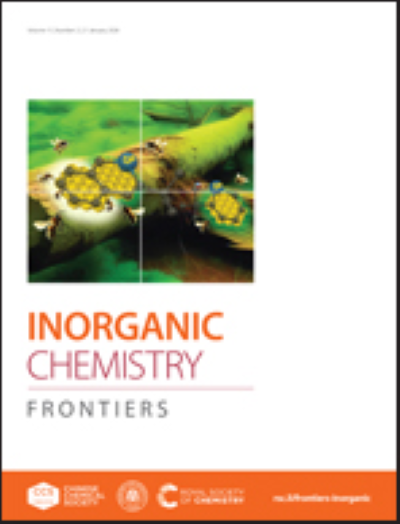带对准驱动的NiFe LDH@CoOx-CNF异质结空间电荷重塑用于高效碱性氧演化
IF 6.1
1区 化学
Q1 CHEMISTRY, INORGANIC & NUCLEAR
引用次数: 0
摘要
虽然异质结工程有望增强基于nife的析氧反应(OER)催化剂,但不匹配的界面费米水平通常会阻碍对OER活性至关重要的高价Ni2+δ物质的形成,从而在电荷转移效率和活性相演化之间产生权衡。本文提出了一种条带对准策略,通过将Co纳米点(20 wt%)控制集成到电纺碳纳米纤维(CoOx-CNF)中,然后再将NiFe LDH纳米片进行鲁棒耦合来解决这一冲突。Co纳米点的存在增强了CNF的石墨化,将界面费米能级偏移调整到1.30 eV,从而建立了从NiFe LDH到CoOx-CNF的定向电子转移通道。由此产生的空间电荷重塑诱导Ni位点的选择性电子耗尽,这协同促进了催化活性Ni2+δ物质的形成,同时加速了电荷转移。因此,这样一个精心设计的NiFe LDH@CoOx-CNF催化剂在10 mA cm⁻²下具有225 mV的超低过电位,并且在100 mA cm⁻²下具有100小时的优异稳定性。Operando电化学阻抗谱直接跟踪微观界面反应和电荷转移机制,而DFT计算表明,带向调节的空间电荷效应改善了电子结构,增强了Ni 3d-O - 2p杂化,从而降低了速率决定步骤(*O→*OOH)的吉布斯自由能垒。本研究建立了相选择电催化剂设计的“带对准→空间电荷重塑→动力学增强”范式。本文章由计算机程序翻译,如有差异,请以英文原文为准。
Band Alignment-Driven Space Charge Remodeling in NiFe LDH@CoOx-CNF Heterojunction for Efficient Alkaline Oxygen Evolution
While heterojunction engineering holds promise for enhancing NiFe-based oxygen evolution reaction (OER) catalysts, poorly matched interfacial Fermi levels often hinders the formation of high-valent Ni2+δ species critical for OER activity, creating a trade-off between charge-transfer efficiency and active-phase evolution. Herein, a band alignment strategy is proposed to resolve this conflict by controlled integration of Co nanodots (20 wt%) into electrospun carbon nanofibers (CoOx-CNF), followed by robust coupling NiFe LDH nanosheets. The presence of Co nanodots enhances CNF graphitization and tailors the interfacial Fermi level offset to 1.30 eV, thereby establishing directional electron transfer channels from NiFe LDH to CoOx-CNF. The resulting space charge remodeling induces selective electron depletion at Ni sites, which synergistically promotes the formation of catalytically active Ni2+δ species while accelerating charge transfer. Therefore, such an elaborately designed NiFe LDH@CoOx-CNF catalyst achieves an ultralow overpotential of 225 mV at 10 mA cm⁻² and exceptional stability for 100 h at 100 mA cm⁻². Operando electrochemical impedance spectroscopy directly tracks microscopic interfacial reactions and charge-transfer mechanisms, while DFT calculations reveal that the band alignment-mediated space charge effect improves the electronic structure and strengthens Ni 3d-O 2p hybridization, thus lowering the Gibbs free energy barrier of the rate-determining step (*O→*OOH). This work establishes a “band alignment→space charge remodeling→kinetic enhancement” paradigm for phase-selective electrocatalyst design.
求助全文
通过发布文献求助,成功后即可免费获取论文全文。
去求助
来源期刊

Inorganic Chemistry Frontiers
CHEMISTRY, INORGANIC & NUCLEAR-
CiteScore
10.40
自引率
7.10%
发文量
587
审稿时长
1.2 months
期刊介绍:
The international, high quality journal for interdisciplinary research between inorganic chemistry and related subjects
 求助内容:
求助内容: 应助结果提醒方式:
应助结果提醒方式:


